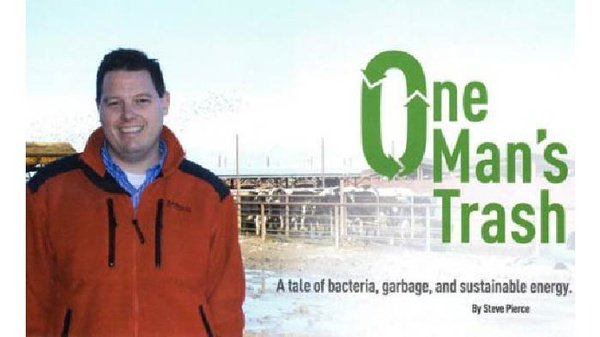Waste Into Renewable Energy
March 23, 2011

Slaughterhouse waste, manure, algae, sawdust, used cooking oil. What common factor unites these seemingly unrelated materials? They are all, in fact, sources of natural energy.
Thanks to Jaron Hansen, a faculty member in the Department of Chemistry and Biochemistry, and Lee Hansen, an emeritus professor of the same department, waste of all kinds may now be used to produce electricity. To market their innovative system, the pair created their own company called Anaerobic Digestion Technology.
To produce energy, the company first gathers its fuel – garbage. This material is then pumped into a large 14-foot by 30-foot vat filled with bacteria. These bacteria eat through practically anything and produce methane gas in the process. As the methane rises to the top of the vat, it is collected through a pipe that channels it into a cleaning chamber.
This cleaning chamber is called the gas conditioning system and is a breakthrough, patent-pending invention by Hansen and Hansen. Although the gas produced by the bacteria is mostly comprised of methane, other contaminants are present that negatively affect electrical generators. Thus, in order to prepare the gas for entrance into the generator, it passes through a container full of zeolite. These beads soak up all the other gases and contaminants and let the methane gas pass easily through, resulting in 98 percent pure methane gas to be burned and converted into electrical power by the generator.
Currently, 100 homes are being powered by Anaerobic Digestion Technology and their partner company Andigen. The Church of Jesus Christ of Latter-day Saints is also interested in this technology. A Church-owned ranch in Elberta, Utah, which maintains roughly 5,000 cows, faces the challenge of removing a large amount of animal waste and it has called upon BYU to put their trash to use as fuel for bacteria. The Church and the university are working together to establish a plant in Elberta that will produce 1.2 megawatts of power for over 1,200 homes and save the church $1 million per year on disposal expenses.
In addition to being burned for electrical power, methane may also be compressed to become liquid car fuel. Yet, despite the huge benefits of methane, it is not the only valuable product of bacteria. What is not converted into gas by the bacteria becomes rich compost, which can then be reused to fertilize the fields that the cows graze on or sold for a large profit in gardening stores.
Along with saving fossil fuels and curbing the damage their smoke may inflict upon the earth’s atmosphere, Jaron Hansen identifies the best part about using waste to power homes.
“It is a renewable source,” he explained with a smile. “We’re all going to keep on making solids.”
See also: "One Man's Trash: A tale of bacteria, garbage, and sustainable energy" by Steve Pierce, Frontiers Magazine, Spring/Summer 2011
By Natalie Wilson, College of Physical and Mathematical Sciences